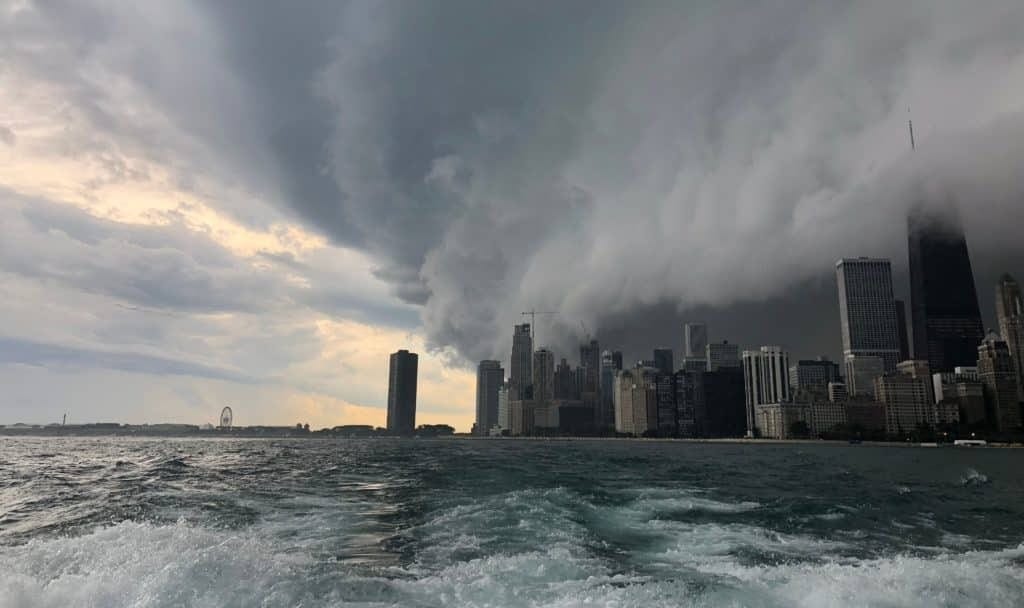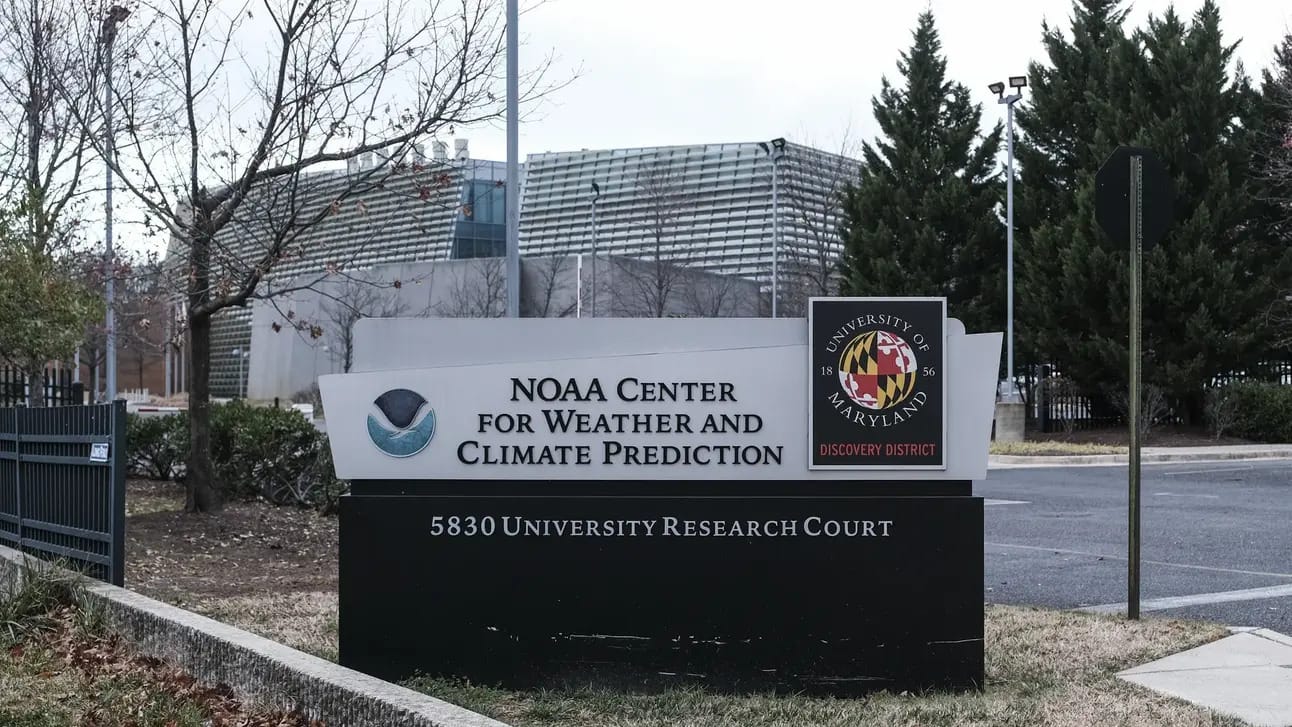
A severe thunderstorm sweeps through Chicago’s Gold Coast in September 2019. Credit: Shutterstock
Elon Musk’s war on expertise has found a new front: the National Oceanic and Atmospheric Administration (NOAA) and the National Weather Service (NWS). As reported by Axios, details are now emerging as to how DOGE-induced budget cuts and lease terminations are gutting the agency responsible for forecasting hurricanes, tornadoes, and other extreme weather events. These cuts put millions of lives in jeopardy and risk catastrophic economic consequences.
For a moment, forget the politics. Just think about the weather.
Every year, the United States is battered by hurricanes, wildfires, winter storms, and deadly heat waves. NOAA isn’t just an academic institution tracking trends; it’s the first line of defense against natural disasters. Through real-time storm tracking, climate models, and timely emergency warnings, it provides crucial information that helps communities prepare and respond before catastrophe strikes.
Now imagine that lifeline fraying.

NOAA's Center for Weather and Climate Prediction headquarters in College Park, Md., is slated for closure. Credit: Michael A. McCoy/Bloomberg via Getty Images
Axios’ reporting highlights that multiple NOAA offices—including those dedicated to hurricane prediction—are losing their leases with no clear plan to relocate. This is a self-inflicted collapse of essential infrastructure. If NOAA’s ability to track storms is compromised, the consequences will be felt in real-time disasters with real human costs.
Take hurricanes, for example. NOAA’s National Hurricane Center (NHC) provides crucial forecasts that determine evacuations. If those forecasts are less precise, or if they arrive later than they should, entire cities could be caught off guard. Look no further than Hurricane Katrina in 2005: early warning failures contributed to thousands of deaths. Conversely, just a few weeks later, NHC tracking allowed Houston officials to prepare for Hurricane Rita, saving countless lives.

Nearly four million people fled Houston ahead of Hurricane Rita — the largest evacuation in U.S. history. Credit: Wikimedia
The same goes for tornadoes. The U.S. experiences more tornadoes than any other country in the world, and lead time for warnings has increased dramatically thanks to NOAA’s research. In the 1980s, people had an average of five minutes to take cover. Today, that window has grown to 13 minutes. That’s the difference between making it to a shelter or being caught in the open. If NOAA’s capabilities are compromised, that progress could be reversed.
These cuts aren’t just about alleged cost savings. The Republican Party has spent years undermining climate science, cutting funding for research, and dismissing warnings from experts. This move fits a pattern: defund agencies that provide inconvenient truths, then claim their absence justifies further inaction.
There’s a cynical calculus at play. Without NOAA’s rigorous climate tracking, it becomes easier to downplay the impact of climate change. If fewer resources go into hurricane prediction, officials can feign ignorance when storms intensify. If NOAA isn’t monitoring rising sea levels, the federal government can drag its feet on climate policy.
But reality doesn’t wait for politics to catch up.
In the past four years, extreme weather has relentlessly battered the nation’s largest cities. Los Angeles has faced devastating wildfires, while tornadoes have torn through Chicago and Dallas. New York and Washington have battled air quality emergencies, and hurricanes have menaced Miami and Tampa. Throughout it all, the NWS’s local offices and prediction centers have been a lifeline, offering crucial forecasts and real-time updates that have saved lives and minimized destruction. Without these vital resources, the impacts could have been catastrophic.

Plumes of smoke are seen from Santa Monica, Calif., as wildfires tore through the Los Angeles area in January. Credit: Getty Images
We are entering an era of more extreme weather, not less. The last decade was the hottest on record. Wildfires are no longer seasonal; they are year-round disasters. Floods that used to occur once a century are now happening every few years. NOAA’s job is to track, predict, and mitigate these crises. Removing its funding isn’t just irresponsible—it’s dangerous.
Let’s set aside the moral argument for a second and focus on dollars and cents. Every year, extreme weather costs the U.S. economy billions. In 2023 alone, the country suffered 28 separate billion-dollar weather disasters. Between damage to infrastructure, disruptions to agriculture, and lost productivity, NOAA’s work directly affects economic stability.
Castrating NOAA isn’t “fiscal responsibility.” It’s financial negligence. If businesses and local governments don’t have access to reliable weather data, they can’t plan for disasters. The insurance industry, which relies on NOAA’s projections, will be thrown into chaos. Supply chains—already fragile—will become even more volatile.
For every dollar invested in disaster preparedness, the federal government saves at least six dollars in recovery costs. Slashing NOAA’s budget doesn’t save money; it creates bigger, costlier emergencies.
If these cuts continue, the following realities are all but certain:
Delays in storm warnings that could mean the difference between survival and catastrophe.
Weaker climate monitoring, giving corporations and policymakers an excuse to ignore rising global temperatures.
Economic instability as weather-driven disasters become harder to predict and prepare for.
A widening knowledge gap, where private companies with expensive proprietary models become the only ones with access to critical weather data—effectively privatizing public safety.
This isn’t just bureaucratic reshuffling. It’s sabotage.

Protesters hold up signs during a large rally outside NOAA offices in Boulder, Colo., on March 3, 2025. Credit: Helen H. Richardson/The Denver Post
The good news?
NOAA scientists are some of the most dedicated professionals in the country, and many are already sounding the alarm. But public pressure is crucial. Congress (for now…) controls the purse strings, and if enough people demand action, funding can be protected. State governments and local agencies can also step in to fill gaps, though that’s not a long-term solution.
Most importantly, this issue needs to be part of the broader conversation about governance in 2025 and beyond. Science and safety should not be partisan issues. Whether you live in a hurricane zone, a tornado alley, or a wildfire-prone area, NOAA’s work affects you. Ignoring these cuts today means paying for them in blood and dollars tomorrow.
NOAA, the White House, and DOGE did not respond to multiple requests for comment.